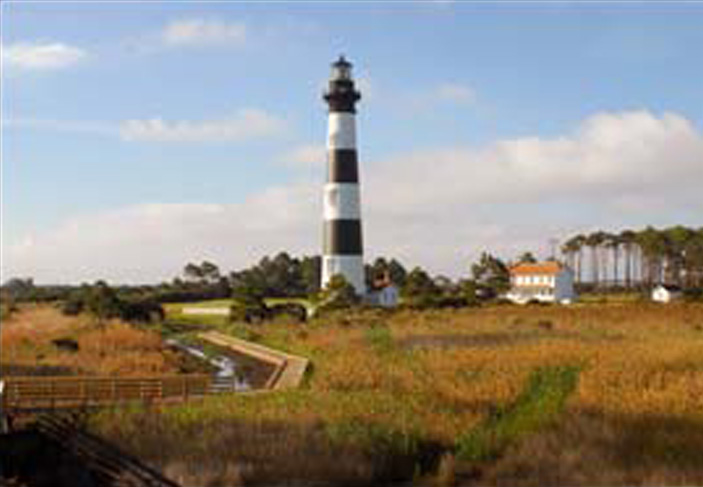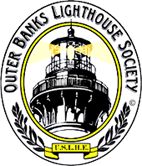BODIE ISLAND LIGHTHOUSE
Bodie Island Lighthouse
Bodie Island, NC
Latitude: 35° 49' 06.8" N
Longitude: 75° 33' 48.0" W
The Bodie Island Lighthouse and its Double Keepers’ Quarters are situated midway between the Atlantic Ocean and the Pamlico Sound within the protection of Cape Hatteras National Seashore. It was completed by the U.S. Light-House Board (aka U.S. Lighthouse Service) in 1872 during the Golden Era of American lighthouse building. Its name originally was spelled “Body’s” on U.S. Lighthouse Service documents. It is alternately suggested that the land was bought from a family with the surname Body or was named for the “body of land” that surrounds it.
This lighthouse had two predecessors. The first was built in 1847 about 1.5 miles south of Oregon Inlet. Due to lack of foresight or in the name of economy, the first tower had no foundation. When the 54-foot tall white brick tower began to lean, its lighting mechanism was damaged. In 1854, the Light-House Board made some repairs including the installation of a fourth-order Fresnel lens, but the failing tower was eventually abandoned.
After the first tower went dark, the 120 miles between Cape Henry and Cape Hatteras were unmarked for mariners again. There remained a great need for a lighthouse at Bodie

Island to warn mariners to begin a swing away from shore and out to sea to avoid wrecking on Diamond Shoals forty miles south off of Cape Hatteras.
In 1858 the government ordered a second Bodie Island tower to be built of the finest materials available. This time, a secure foundation was laid for the white, eighty-foot-tall tower, and it was fitted with a third-order Fresnel lens. But darker days lay ahead when the lighthouse was destroyed by Confederate armies in 1861, becoming one of the first victims of the Civil War.
After the war, the Light-House Board began repairing war-damaged towers as well as constructing new lights. The site for the present 1870 Bodie Island Light Station was chosen further north, away from the migrating Oregon Inlet.
With the experience of building a successful foundation at Cape Hatteras, Dexter Stetson, superintendent of construction, opted to use the same timber-and-rubble foundation at Bodie Island. Above the wood and granite foundation, nearly one million bricks were laid in a double-wall construction and topped by an iron lantern room. The architectural drawings used at Bodie Island were first drawn for the St. Augustine Lighthouse in Florida, and used again for the Morris Island Lighthouse in South Carolina, the Sand Island Lighthouse in Alabama, and for the Currituck Beach Light as well.
The soul of the lighthouse is its first-order Fresnel lens from Barbier & Fenestre of Paris, France. This magnificent light has served both seagoing vessels as well as local traffic on Pamlico Sound. The lamp inside the lens was lit thirty minutes before sunset and extinguished the following morning thirty minutes after sunrise.
To modernize the lighthouse, the Lighthouse Service installed an incandescent light inside the Fresnel lens that was powered by banks of batteries set in the two workrooms inside the entryway. A flash control motor produced the characteristic flash of 2.5 seconds on, 2.5 off, 2.5 on, and 22.5 seconds off. When the light was electrified in 1932, a 1,000-watt bulb with automatic changer was installed.
In July 2000, the Bodie Island Lighthouse was officially transferred from the U.S. Coast Guard (USCG) to the National Park Service. The lens remained an active aid to navigation and the property of the USCG.
On April 25, 2005, the USCG transferred the title of the first-order Fresnel lens to the National Park Service and the lens is lighted each evening as an active aid to navigation. The tower underwent restoration in 2008; meanwhile, the lens was also restored. Outer Banks Lighthouse Society (OBLHS) volunteers helped with the restoration process. The lighthouse opened to public climbing in 2013 and in October of that year, OBLHS and the NPS hosted a homecoming for Bodie Island keepers' descendants.
The Honorable Senator Marc Basnight requested state funds to build a new walkway adjacent to and in back of the lighthouse, which was completed in summer 2009. It has become the classic view of this light station.

Photo by Bruce Roberts
Federal funding for the direly needed restoration also became available in 2009 that allowed removal and restoration of the rare first-order Fresnel lens; restoration of the tower began in early 2010. Outer Banks Lighthouse Society (OBLHS) volunteers helped with the lens restoration process.
After the lens was restored and two phases of lighthouse restoration work were completed over a five-year period, the lens was reset in the lantern room. Both lens and tower restoration projects were complete successes.
In spring 2013, the lighthouse opened to the public for climbing for the first time in its history. Later that year in October, OBLHS organized and hosted with the NPS a homecoming for Bodie Island Lighthouse keepers’ descendants.
-----------------------------------------------------------------------------------------------------
The Keepers’ Quarters at Bodie Island houses a visitor center, displays on the lighthouse, and a bookstore on the first floor. Park Ranger offices are upstairs.
Bodie Island Lighthouse is located within the Cape Hatteras National Seashore. The light station grounds are open year-round. After many years of restoration, the lighthouse opened to the public for the first time for climbing on April 19, 2013. It opens each April and remains open daily during good weather until Columbus Day. Climbing tickets are $10 for adults and $5 for senior citizens (62 or older), children (11 and under, and at least 42" tall), and the disabled. More information can be found at the Bodie Island Lighthouse main website and the Lighthouse Climbs website.
Directions
From NC 158 in Nags Head, travel south on NC 12 into the Cape Hatteras National Seashore for approximately six miles until you see the Bodie Island Lighthouse signs. Turn right into the entrance to the light station on a two-lane asphalt road and go approximately one and one-half miles which into the lighthouse parking lot. The tower is open seasonally for climbing but the light station grounds remain open year-round.
In 2009, prior to even touching the lens to restore it, a “micro-climate” was installed to cool the air in the lantern room and release humidity. Next, the entire lens was cleaned, prism by prism; any existing prism damage was repaired and all putty joints renewed. In this picture, working above the lens, Nick Johnston is standing on a platform built around the lens to access the upper lens support system. The lens had to be freed from its sixteen-armed metal support. Conservators had to support the lens from above before the release.
Cautious movement and concentration are required for safe removal of a prism panel from its frame. Here, one conservator eases an upper catadioptric panel from inside the lens toward three others outside the lens. Each panel weighs in at 150 pounds or more, and the handling of these delicate panels of prisms is tedious work.
Once the panels were freed from the lens frame, the next step is just as difficult. Each part of the lens had to be taken from the lantern room to the level below. Iron steps on glass prisms are unforgiving; therefore, all caution was made not to create one tiny chip in any prism.
Once a panel was on the top landing, it was wrapped, boxed, and prepared to be lifted over the stair railing by block and tackle. It was then carefully lowered down the center of the “well” to the bottom of the stairs. A ramp had been built to help ease each panel out of the lighthouse to be transported to the warehouse/museum area of the park in Manteo twelve miles to the northwest on Roanoke Island.
Volunteers for the Outer Banks Lighthouse Society and National Park Service cleaned, specially wrapped any prism needing more attention, and packed the lens for storage. At left foreground is Kim Fahlen, photo- grapher for the lens restoration process for conservators of Lighthouse Lamp Shop.
Photographs and information are courtesy of Kim Fahlen. Volunteer photograph is by Diana Chappell.
